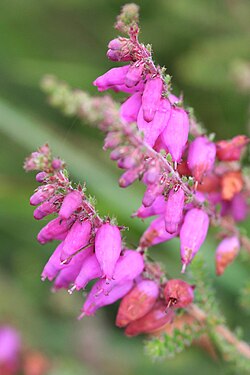Erica (plant)
Genus of flowering plants in the family Ericaceae From Wikipedia, the free encyclopedia
Erica is a genus of roughly 857 species of flowering plants in the family Ericaceae.[3] The English common names heath and heather are shared by some closely related genera of similar appearance. The genus Calluna was formerly included in Erica – it differs in having even smaller scale-leaves (less than 2–3 millimetres long), and the flower corolla consisting of separate petals. Erica is sometimes referred to as "winter (or spring) heather" to distinguish it from Calluna "summer (or autumn) heather".
| Erica | |
|---|---|
 | |
| Erica carnea in flower | |
| Scientific classification | |
| Kingdom: | Plantae |
| Clade: | Tracheophytes |
| Clade: | Angiosperms |
| Clade: | Eudicots |
| Clade: | Asterids |
| Order: | Ericales |
| Family: | Ericaceae |
| Subfamily: | Ericoideae |
| Tribe: | Ericeae |
| Genus: | Erica L. |
| Species | |
| Synonyms[1][2] | |
|
List
| |
Description
Most of the species of Erica are small shrubs from 20–150 centimetres (8–59 inches) high, though some are taller; the tallest are E. arborea (tree heath) and E. scoparia (besom heath), both of which can reach up to 7 metres (23 feet) tall. All are evergreen, with minute, needle-like leaves 2–15 millimetres (1⁄8–5⁄8 in) long. Flowers are sometimes axillary, and sometimes borne in terminal umbels or spikes, and are usually outward or downward facing. The seeds are very small, and in some species may survive in the soil for decades.
Taxonomy
Summarize
Perspective
Dulfer[4][5] published the last revision of the genus Erica in the 1960s, treating 605 species. Many new species have subsequently been described (particularly in South Africa) and a further 83 have been included in Erica from former "minor genera", such as Phillipia Klotzsch and Blaeria L.[6] A more recent overview of Erica species is provided in an electronic identification aid,[7] but a modern taxonomic revision of the genus as a whole is still lacking.
Phylogeny
A number of increasingly detailed phylogenetic hypotheses for Erica have been published based on nuclear ribosomal and plastid DNA sequences.[8][9][10][11] The closest relatives of Erica are Daboecia (one or two species) and Calluna (monospecific), representing the oldest surviving lineages of a, by inference, ancestrally Palearctic tribe Ericeae.[9] The small number of European Erica species represent the oldest lineages of the genus, within which a single, order-of-magnitude more species-rich, African clade is nested.[10] Within the African clade, Cape and Madagascan/Mascarene species respectively represent monophyletic groups.[11]
Species
Selected species include:
- Erica abietina
- Erica afra
- Erica arborea
- Erica australis
- Erica azorica
- Erica baccans
- Erica cabernetea
- Erica canaliculata
- Erica capensis
- Erica carnea
- Erica cerinthoides
- Erica ciliaris
- Erica cinerea
- Erica comorensis
- Erica cruenta
- Erica × darleyensis
- Erica erigena
- Erica grandiflora
- Erica haematocodon
- Erica hirtiflora
- Erica jasminiflora
- Erica lusitanica
- Erica mackayana
- Erica mammosa
- Erica manipuliflora
- Erica margaritacea
- Erica mollis
- Erica multiflora
- Erica nana
- Erica nyassana
- Erica patersonia
- Erica peltata
- Erica plukenetii
- Erica pyramidalis
- Erica recurvata
- Erica reunionensis
- Erica scoparia
- Erica terminalis
- Erica tetralix
- Erica turgida
- Erica urna-viridis
- Erica vagans
- Erica ventricosa
- Erica versicolor
- Erica verticillata
- Heather fields in Ortegal (Galicia, Spain)
Etymology
The Latin word erica means "heath" or "broom".[12] It is believed that Pliny adapted erica from Ancient Greek ἐρείκη.[13] The expected Anglo-Latin pronunciation, /ɪˈraɪkə/, may be given in dictionaries (OED: "Erica"), but /ˈɛrɪkə/ is more commonly heard.[14]
Distribution and habitat
Around 690 of the species are endemic to South Africa, and these are often called the Cape heaths, forming the largest genus in the fynbos.[15] The remaining species are native to other parts of Africa, Madagascar, the Mediterranean, and Europe.
Like most Ericaceae, Erica species are mainly calcifuges, being limited to acidic or very acidic soils. In fact, the term "ericaceous" is frequently applied to all calcifuges, and to the compost used in their cultivation.[16] Soils range from dry, sandy soils to extremely wet ones such as bog. They often dominate dwarf-shrub habitats (heathland and moorland), or the ground vegetation of open acidic woodland.
Ecology
Plants of this genus are eaten mainly by the larvae of many Lepidoptera species, including Saturnia pavonia, garden tiger moth, true lover's knot, wormwood pug, the silver-studded blue,[17] and the Coleophora case-bearers C. juncicolella and C. pyrrhulipennella.
Some species of sunbirds are known to visit and pollinate Erica. Two such species are the southern double-collared sunbird and the orange-breasted sunbird.
Cultivation

Erica species are grown as landscape or garden plants for their floral effect. They associate well with conifers and are frequently seen in planting schemes as massed groundcover beneath varieties of dwarf conifers. They are capable of producing flower colour throughout the year. They can also be grown in tubs or window boxes to provide interest through autumn and into winter.[18]
The cultivation of larger beds of heath rather than individual plants became more popular in the 1920s, after gardeners began to try and replicate natural heathland environments in their gardens.[19]
References
Wikiwand - on
Seamless Wikipedia browsing. On steroids.






